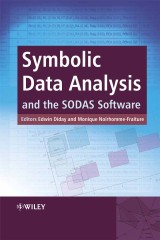Details

Symbolic Data Analysis and the SODAS Software
1. Aufl.
|
145,99 € |
|
| Verlag: | Wiley |
| Format: | |
| Veröffentl.: | 15.04.2008 |
| ISBN/EAN: | 9780470723555 |
| Sprache: | englisch |
| Anzahl Seiten: | 476 |
DRM-geschütztes eBook, Sie benötigen z.B. Adobe Digital Editions und eine Adobe ID zum Lesen.
Beschreibungen
Symbolic data analysis is a relatively new field that provides a range of methods for analyzing complex datasets. Standard statistical methods do not have the power or flexibility to make sense of very large datasets, and symbolic data analysis techniques have been developed in order to extract knowledge from such data. Symbolic data methods differ from that of data mining, for example, because rather than identifying points of interest in the data, symbolic data methods allow the user to build models of the data and make predictions about future events.<br /> This book is the result of the work f a pan-European project team led by Edwin Diday following 3 years work sponsored by EUROSTAT. It includes a full explanation of the new SODAS software developed as a result of this project. The software and methods described highlight the crossover between statistics and computer science, with a particular emphasis on data mining.<br />
Contributors. <p>Foreword.</p> <p>Preface.</p> <p>ASSO Partners.</p> <p>Introduction.</p> <p>1. The state of the art in symbolic data analysis: overview and future (Edwin Diday).</p> <p><b>PART I. DATABASES VERSUS SYMBOLIC OBJECTS.</b></p> <p>2. Improved generation of symbolic objects from relational databases (Yves Lechevallier, Aicha El Golli and George Hébrail).</p> <p>3. Exporting symbolic objects to databases (Donato Malerba, Floriana Esposito and Annalisa Appice).</p> <p>4. A statistical metadata model for symbolic objects (Haralambos Papageorgiou and Maria Vardaki).</p> <p>5. Editing symbolic data (Monique-Noirhomme-Fraiture, Paula Brito, Anne de Baenst-Vandenbroucke and Adolphe Nahimana).</p> <p>6. The normal symbolic form (Marc Csernel and Francisco de A.T. de Carvalho).</p> <p>7. Visualization (Monique-Noirhomme-Fraiture and Adolphe Nahimana).</p> <p><b>PART II. UNSUPERVISED METHODS.</b></p> <p>8. Dissimilarity and matching (Floriana Esposito, Donato Malerba and Annalisa Appice).</p> <p>9. Unsupervised divisive classification (Jean-Paul Rasson, Jean-Yves Pirçon, Pascale Lallemand and Séverine Adans).</p> <p>10. Hierarchical and pyramidal clustering (Paula Brito and Francisco de A.T. de Carvalho).</p> <p>11 .Clustering methods in symbolic data analysis (Francisco de A.T. de Carvalho, Yves Lechevallier and Rosanna Verde).</p> <p>12. Visualizing symbolic data by Kohonen maps (Hans-Hermann Bock).</p> <p>13 .Validation of clustering structure: determination of the number of clusters (André Hardy).</p> <p>14. Stability measures for assessing a partition and its clusters: application to symbolic data sets (Patrice Bertrand and Ghazi Bel Mufti).</p> <p>15. Principal component analysis of symbolic data described by intervals (N.Carlo Lauro, Rosanna Verde and Antonio Irpino).</p> <p>16. Generalized canonical analysis (N.Carlo Lauro, Rosanna Verde and Antonio Irpino).</p> <p><b>PART III .SUPERVISED METHODS.</b></p> <p>17. Bayesian decision trees (Jean-Paul Rasson, Pascale Lallemand and Séverine Adans).</p> <p>18. Factor discriminant analysis (N.Carlo Lauro, Rosanna Verde and Antonio Irpino).</p> <p>19. Symbolic linear regression methodology (Filipe Afonso, Lynne Billard, Edwin Diday and Mehdi Limam).</p> <p>20. Multi-layer perceptrons and symbolic data (Fabrice Rossi and Brieuc Conan-Guez).</p> <p><b>PART IV. APPLICATION AND THE SODAS SOFTWARE.</b></p> <p>21. Application to the Finnish, Spanish and Portuguese data of the European Social Survey (Soile Mustjärvi and Seppo Laaksonen).</p> <p>22. People’s life values and trust components in Europe: symbolic data analysis for 20-22 countries (Seppo Laaksonen).</p> <p>23. Symbolic analysis of the Time Use Survey in the Basque country (Marta Mas and Haritz Olaeta).</p> <p>24. SODAS2 software: overview and methodology (Anne de Baenst-Vandenbroucke and Yves Lechevallier).</p> <p>Index.</p>
<b>Edwin Diday</b>, Centre De Recherche en Mathématiques de la Décision, Université Paris 9, France<br /> Edwin is a Professor of Computer Science, with 50 published papers, and 14 authored or edited books to his name. He has led international research teams in Symbolic Data Analysis, and is the founder of the field. <p><b>M. Noirhomme-Fraiture</b>, Institute of Computer Science, University of Namur, Belgium<br /> Monique Noirhomme-Fraiture is Professor and Head of the Unit of Applied Mathematics at the above faculty. She is involved in several HCI projects as well as having organized conferences and workshops within this field. She has contributed to 28 published papers and co-authored 2 books.</p>
Classical statistical techniques are often inadequate when it comes to analysing some of the large and internally variable datasets common today. Symbolic Data Analysis (SDA) has evolved in response to this problem and is a vital tool for summarizing information in such a way that the resulting data is of a manageable size. Symbolic data, represented by <p>intervals, lists, histograms, distributions, curves and the like, keeps the "internal variation" of summaries better than standard data. SDA therefore plays a key role in the interaction between statistics and data processing, and has established itself as an important tool for analysing official statistics.</p> <p>Through an extension of the concepts employed in data mining, the Editors provide an advanced guide to the techniques required to analyse symbolic data. Contributions from leading experts in the field enable the reader to build models and make predictions about future events.</p> <p>The book:</p> <ul class="noindent"> <li>Provides new graphical tools for the interpretation of large data sets.</li> </ul> <ul class="noindent"> <li>Extends standard statistics, data analysis, data mining and knowledge discovery to symbolic data.</li> </ul> <ul class="noindent"> <li>Introduces the SODAS software, which is complementary to existing data analysis software (e.g. SAS, SPSS, SPAD) that are unable to work on symbolic data.</li> </ul> <ul class="noindent"> <li>Induces, exports, and compares knowledge from one database to another.</li> </ul> <ul class="noindent"> <li>Features a supporting website hosting the software, and user manual.</li> </ul> <p>Symbolic Data Analysis and the SODAS Software is primarily aimed at practitioners of symbolic data analysis, such as statisticians and economists, within both the public and private sectors. There is also much of interest to postgraduate students and researchers within web mining, text mining, and bioengineering.</p>
Diese Produkte könnten Sie auch interessieren:

Nonparametric Regression Methods for Longitudinal Data Analysis

von: Hulin Wu, Jin-Ting Zhang

135,99 €

Statistics and the Evaluation of Evidence for Forensic Scientists

von: Colin Aitken, Franco Taroni

103,99 €














